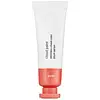What's inside
What's inside
 Key Ingredients
Key Ingredients

 Benefits
Benefits

 Concerns
Concerns

 Ingredients Side-by-side
Ingredients Side-by-side

Cream
EmollientSynthetic Fluorphlogopite
Mica
Cosmetic ColorantMagnesium Myristate
Octyldodecyl Stearoyl Stearate
EmollientSilica
AbrasiveGlyceryl Triacetyl Ricinoleate
EmollientNylon-12
PEG-12 Dimethicone
Skin ConditioningCaprylic/Capric Triglyceride
MaskingTocopheryl Acetate
AntioxidantCaprylyl Glycol
EmollientPolyhydroxystearic Acid
EmulsifyingHexylene Glycol
EmulsifyingHydrogenated Phosphatidylcholine
EmulsifyingTrimyristin
Skin ConditioningTriethoxycaprylylsilane
Phenoxyethanol
PreservativePotassium Sorbate
PreservativeTin Oxide
AbrasiveCI 77891
Cosmetic ColorantCI 15850
Cosmetic ColorantCI 77492
Cosmetic ColorantCI 77163
Cosmetic ColorantCI 19140
Cosmetic ColorantCI 73360
Cosmetic ColorantCI 45410
Cosmetic ColorantPPG-3 Benzyl Ether Myristate
EmollientEthylhexyl Stearate
EmollientDipentaerythrityl Hexahydroxystearate/Hexastearate/Hexarosinate
Skin ConditioningTriisostearyl Citrate
EmollientDiisostearyl Malate
EmollientPolyethylene
AbrasivePolybutene
Vinyl Dimethicone/Methicone Silsesquioxane Crosspolymer
Disteardimonium Hectorite
StabilisingOctyldodecanol
EmollientPentaerythrityl Tetra-Di-T-Butyl Hydroxyhydrocinnamate
AntioxidantPropylene Carbonate
SolventFarnesol
PerfumingLinalool
PerfumingCI 77491
Cosmetic ColorantCream, Synthetic Fluorphlogopite, Mica, Magnesium Myristate, Octyldodecyl Stearoyl Stearate, Silica, Glyceryl Triacetyl Ricinoleate, Nylon-12, PEG-12 Dimethicone, Caprylic/Capric Triglyceride, Tocopheryl Acetate, Caprylyl Glycol, Polyhydroxystearic Acid, Hexylene Glycol, Hydrogenated Phosphatidylcholine, Trimyristin, Triethoxycaprylylsilane, Phenoxyethanol, Potassium Sorbate, Tin Oxide, CI 77891, CI 15850, CI 77492, CI 77163, CI 19140, CI 73360, CI 45410, PPG-3 Benzyl Ether Myristate, Ethylhexyl Stearate, Dipentaerythrityl Hexahydroxystearate/Hexastearate/Hexarosinate, Triisostearyl Citrate, Diisostearyl Malate, Polyethylene, Polybutene, Vinyl Dimethicone/Methicone Silsesquioxane Crosspolymer, Disteardimonium Hectorite, Octyldodecanol, Pentaerythrityl Tetra-Di-T-Butyl Hydroxyhydrocinnamate, Propylene Carbonate, Farnesol, Linalool, CI 77491
Water
Skin ConditioningCyclopentasiloxane
EmollientMethyl Trimethicone
Skin ConditioningButylene Glycol
HumectantPEG-10 Dimethicone
Skin ConditioningMica
Cosmetic ColorantDicaprylyl Carbonate
EmollientNeopentyl Glycol Diheptanoate
EmollientDisteardimonium Hectorite
StabilisingGlycerin
HumectantVinyl Dimethicone/Methicone Silsesquioxane Crosspolymer
Sorbitan Isostearate
EmulsifyingSoluble Collagen
HumectantEthylhexylglycerin
Skin ConditioningMagnesium Sulfate
Dimethicone/Vinyl Dimethicone Crosspolymer
Skin ConditioningMethyl Methacrylate Crosspolymer
Triethoxycaprylylsilane
Disodium EDTA
Polyglyceryl-2 Triisostearate
EmulsifyingPentylene Glycol
Skin ConditioningPhenoxyethanol
PreservativeSilica
AbrasiveAluminum Hydroxide
EmollientTin Oxide
AbrasiveCI 77891
Cosmetic ColorantIron Oxides
CI 75470
Cosmetic ColorantCI 73360
Cosmetic ColorantCI 15985
Cosmetic ColorantWater, Cyclopentasiloxane, Methyl Trimethicone, Butylene Glycol, PEG-10 Dimethicone, Mica, Dicaprylyl Carbonate, Neopentyl Glycol Diheptanoate, Disteardimonium Hectorite, Glycerin, Vinyl Dimethicone/Methicone Silsesquioxane Crosspolymer, Sorbitan Isostearate, Soluble Collagen, Ethylhexylglycerin, Magnesium Sulfate, Dimethicone/Vinyl Dimethicone Crosspolymer, Methyl Methacrylate Crosspolymer, Triethoxycaprylylsilane, Disodium EDTA, Polyglyceryl-2 Triisostearate, Pentylene Glycol, Phenoxyethanol, Silica, Aluminum Hydroxide, Tin Oxide, CI 77891, Iron Oxides, CI 75470, CI 73360, CI 15985
 Reviews
Reviews

Ingredients Explained
These ingredients are found in both products.
Ingredients higher up in an ingredient list are typically present in a larger amount.
Ci 73360 is a synthetic red-pink dye.
Ci 77891 is a white pigment from Titanium dioxide. It is naturally found in minerals such as rutile and ilmenite.
It's main function is to add a white color to cosmetics. It can also be mixed with other colors to create different shades.
Ci 77891 is commonly found in sunscreens due to its ability to block UV rays.
Learn more about CI 77891Disteardimonium Hectorite comes from the clay mineral named hectorite. It is used to add thickness to a product.
It can also help stabilize a product by helping to disperse other ingredients.
Hectorite is a rare, white clay mineral.
Learn more about Disteardimonium HectoriteMica is a naturally occurring mineral used to add shimmer and color in cosmetics. It can also help improve the texture of a product or give it an opaque, white/silver color.
Serecite is the name for very fine but ragged grains of mica.
This ingredient is often coated with metal oxides like titanium dioxide. Trace amounts of heavy metals may be found in mica, but these metals are not harmful in our personal products.
Mica has been used since prehistoric times throughout the world. Ancient Egyptian, Indian, Greek, Roman, Aztec, and Chinese civilizations have used mica.
Learn more about MicaPhenoxyethanol is a preservative that has germicide, antimicrobial, and aromatic properties. Studies show that phenoxyethanol can prevent microbial growth. By itself, it has a scent that is similar to that of a rose.
It's often used in formulations along with Caprylyl Glycol to preserve the shelf life of products.
Silica, also known as silicon dioxide, is a naturally occurring mineral. It is used as a fine, spherical, and porous powder in cosmetics.
Though it has exfoliant properties, the function of silica varies depending on the product.
The unique structure of silica enhances the spreadability and adds smoothness, making it a great texture enhancer.
It is also used as an active carrier, emulsifier, and mattifier due to its ability to absorb excess oil.
In some products, tiny microneedles called spicules are made from silica or hydrolyzed sponge. When you rub them in, they lightly polish away dead skin layers and enhance the penetration of active ingredients.
Learn more about SilicaTin Oxide is an inorganic oxide used to add opacity and volume to a product. In nature, it is already found in mineral form. The main ore of tin is an opaque and shiny mineral called casseterite.
Tin Oxide helps remove translucency in a product, or make it more opaque. Besides adding opacity, tin oxide is used for bulking to add volume.
Triethoxycaprylylsilane is a silicone used to bind and stabilize ingredients.
As an emulsifier, it helps prevent ingredients from separating. This can help elongate the shelf life of products.
Triethoxycaprylylsilane is often used to coat mineral sunscreens ingredients to help give a better feel. It also helps reduce oxidative stress in sunscreens.
Learn more about TriethoxycaprylylsilaneThis ingredient is used in makeup and skincare to thicken formulas, reduce shine, and give skin a silky-smooth feel.
It’s a white silicone powder that sits in fine lines and pores to blur their appearance though its effectiveness depends on the particle size.
You'll typically find this ingredient in amounts between 0.1-20%.
Learn more about Vinyl Dimethicone/Methicone Silsesquioxane Crosspolymer